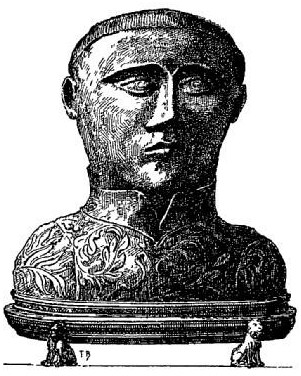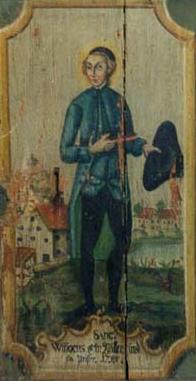
Samson of Dol was a Cornish saint, who is also counted among the seven founder saints of Brittany with Pol Aurelian, Tugdual or Tudwal, Brieuc, Malo, Patern (Paternus) and Corentin. Born in southern Wales, he died in Dol-de-Bretagne, a small town in north Brittany.

Saint Piran's Flag is the flag of Cornwall. The earliest known description of the flag, referred to as the Standard of Cornwall, was written in 1838. It is used by some Cornish people as a symbol of their identity.

Saint Petroc or Petrock was a British prince and Christian saint.

Saint-Brieuc is a city in the Côtes-d'Armor department in Brittany in northwestern France.
Breage or Breaca is a saint venerated in Cornwall and South West England. According to her late hagiography, she was an Irish nun of the 5th or 6th century who founded a church in Cornwall. The village and civil parish of Breage in Cornwall are named after her, and the local Breage Parish Church is dedicated to her. She is a saint in the Eastern Orthodox Church and Catholic Church.
Tro Breizh is a Catholic pilgrimage that links the towns of the seven founding saints of Brittany. These seven saints were Celtic monks from Britain from around the 5th or 6th century who brought Christianity to Armorica and founded its first bishoprics.

The Bretons are a Celtic ethnic group native to Brittany. They trace much of their heritage to groups of Brittonic speakers who emigrated from southwestern Great Britain, particularly Cornwall and Devon, mostly during the Anglo-Saxon settlement of Britain. They migrated in waves from the 3rd to 9th century into Armorica, which was subsequently named Brittany after them.

Cubert is a village in Cornwall, England, United Kingdom. It is three miles (5 km) south-southwest of Newquay and is in the civil parish of Cubert.

Winwaloe was the founder and first abbot of Landévennec Abbey, also known as the Monastery of Winwaloe. It was just south of Brest in Brittany, now part of France.

Saint Winnoc was an abbot or prior of Wormhout who came from Wales. Three lives of this saint are extant. The best of these, the first life, was written by a monk of St. Bertin in the middle of the ninth century, or perhaps a century earlier BHL.

Saint Carantoc, also anglicized as Carantock, Carannog and by other spellings, was a 6th-century abbot, confessor, and saint in Wales and the West Country. He is credited with founding Llangrannog, Ceredigion, Wales and St Carantoc's Church, Crantock. His name is listed amongst the Cornish Saints. Carantoc's is one of five insular saints' lives and two Breton ones that mention Arthur in contexts that may be independent of Geoffrey of Monmouth's Historia Regum Britanniae. He is venerated by the Eastern Orthodox Church and Roman Catholic Church.

Saint Budoc of Dol was a Bishop of Dol, venerated after his death as a saint in both Brittany and Devon. Saint Budoc is the patron of Plourin Ploudalmezeau in Finistère where his relics are preserved. His feast day was celebrated on 8 December, the date still used in Devon, but in Brittany this was moved to 9 December.
There is archaeological evidence of insular monasticism as early as the mid 5th century, influenced by establishments in Gaul such as the monastery of Martin of Tours at Marmoutier, the abbey established by Honoratus at Lérins; and that of Germanus at Auxerre. Many Irish monks studied at Candida Casa near Whithorn in what is now Galloway in Scotland.

Padarn was an early 6th century British Christian abbot-bishop who founded St Padarn's Church in Ceredigion, Wales. He appears to be one and the same with the first bishop of Braga and Saint Paternus of Avranches in Normandy. Padarn built a monastery in Vannes and is considered one of the seven founding saints of Brittany. Padarn's early vita is one of five insular and two Breton saints' lives that mention King Arthur independently of Geoffrey of Monmouth's Historia Regum Britanniae.
Conomor, also known as Conomerus or Conomor the Cursed, was an early medieval ruler of Brittany. His name, which has the Welsh cognate Cynfawr, means "Great Dog", but could also indicate "Sea Dog" in early Brythonic. Conomor was notorious for his cruelty, becoming a legendary villain in Breton culture. He is widely regarded as one of the probable sources for the myth of Bluebeard and possibly also of Tristan's uncle King Mark of Cornwall. The wife-beating giant Cormoran may also retain a garbled folk memory of the same character.
Saint Cadfan, sometimes Anglicized as Gideon, was the 6th century founder-abbot of Tywyn and Bardsey, both in Gwynedd, Wales. He was said to have received the island of Bardsey from Saint Einion Frenin, king of Llŷn, around 516 and to have served as its abbot until 542.
Elwen was the name of an early saint or saints venerated in Cornwall and Brittany. The hagiographical material asserts that he came to Cornwall from Ireland in the company of Breage and six others, but this is attested late. A chapel at Porthleven in Sithney parish, Cornwall, dedicated to Elwen, existed from the 13th century until 1549, and in Brittany several sites and placenames are associated with possibly related figures.

Maudez is a Breton saint who lived in the 5th or 6th century. He is also known as Maudé, Maudet, Maodez or Modez (Breton), Maudetus (Latin), Mandé (French) and Mawes. In the Breton calendar his feast is 18 November.

Saint Teilo, also known by his Cornish name Eliud, was a British Christian monk, bishop, and founder of monasteries and churches. He was from Penalun (Penally) near Tenby in Pembrokeshire, south Wales.













